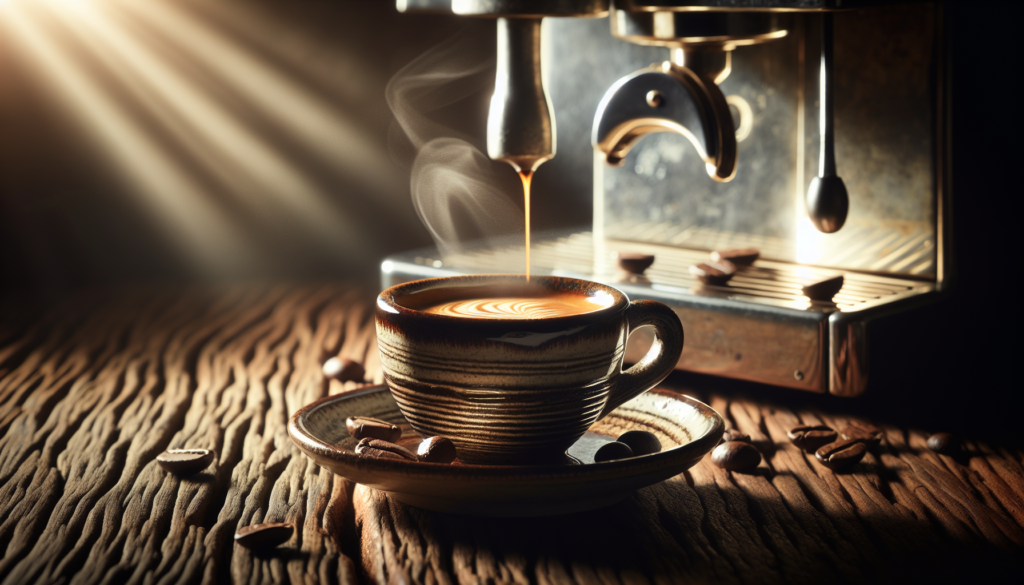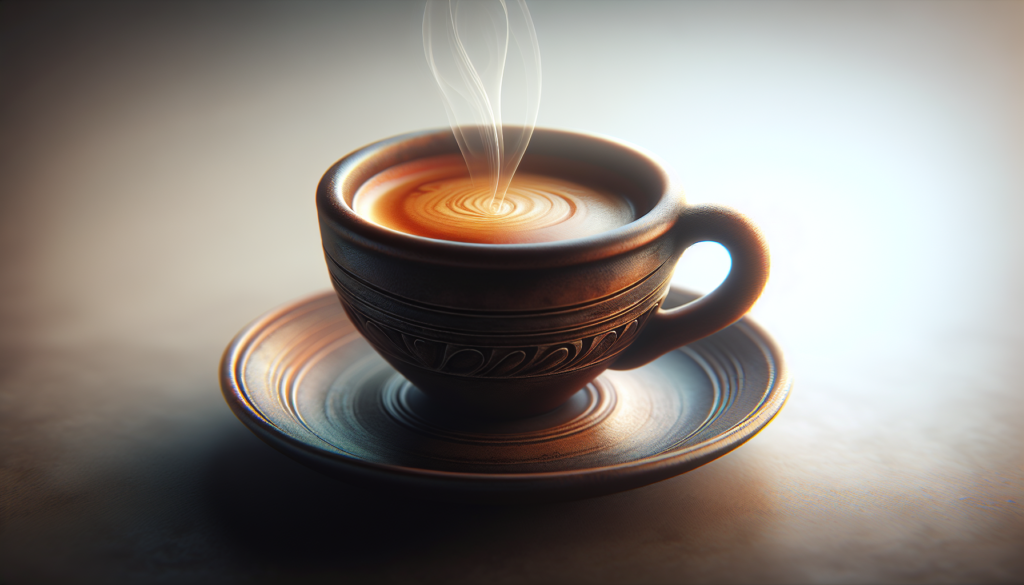Have you ever wondered what makes espresso so special? It’s more than just a strong cup of coffee – it’s a unique brewing method that produces a concentrated and intense flavor. The secret lies in the finely ground coffee beans and the high pressure used to extract the rich oils and flavors. But espresso is not only about the taste; it’s a cultural experience that brings people together, whether it’s enjoying a quick shot at a bustling café in Italy or sipping a creamy latte in the comfort of your own home. So, let’s explore what makes espresso truly one-of-a-kind.

The History of Espresso
The Origins of Espresso
Espresso, a concentrated form of coffee, has a rich and fascinating history that dates back centuries. Its origins can be traced back to 19th-century Italy, where the quest for a quick and flavorful cup of coffee led to the development of the espresso we know today. In the bustling cafes of Milan and Turin, Italians were searching for a way to brew coffee faster and serve it to their customers with efficiency. This desire for speed and convenience ultimately resulted in the birth of espresso.
The Invention of the Espresso Machine
The invention of the espresso machine was a pivotal moment in the history of coffee. In 1884, Angelo Moriondo, an Italian inventor, patented the first device specifically designed for brewing espresso. Moriondo’s machine used steam and pressure to force hot water through coffee grounds, creating a cup of strong, concentrated coffee in a matter of seconds. While Moriondo’s invention was a groundbreaking achievement, it was not until the early 20th century that espresso machines truly began to gain popularity.
The Spread of Espresso Across Europe
After its invention, espresso quickly gained popularity in Italy, spreading to other European countries. In the early 20th century, espresso bars began to emerge throughout Europe, serving as social hubs where people could gather, socialize, and enjoy a cup of espresso. Italy, in particular, embraced espresso culture, with espresso bars becoming an essential part of Italian daily life. The spread of espresso across Europe influenced and shaped coffee culture, eventually leading to the global appreciation and love for espresso that we see today.
The Characteristics of Espresso
The Brewing Process
The brewing process for espresso is unique and distinct from other methods of coffee brewing. Typically, finely ground coffee beans are tightly packed into a portafilter, which is then attached to an espresso machine. Hot water is then forced through the compacted coffee grounds under high pressure, extracting the flavors and oils from the beans quickly. This rapid extraction process contributes to the rich and intense flavor profile of espresso.
The Flavor Profile of Espresso
One of the most defining characteristics of espresso is its distinct and intense flavor profile. Espresso is known for its bold, concentrated taste, with notes of chocolate, caramel, and nuttiness. Unlike drip coffee, which can be more diluted, espresso packs a powerful punch of flavor in just a few ounces. The combination of the brewing process, the type of coffee beans used, and the skill of the barista all contribute to the complex and robust flavors found in a well-prepared espresso shot.
The Crema
Another characteristic unique to espresso is the crema, a layer of foam that forms on top of the brewed espresso. The crema is created by the emulsification of oils present in the coffee beans during the brewing process. It is often a rich, golden-brown color and provides a velvety texture and visual appeal to the espresso. The presence of crema is considered a sign of a well-extracted espresso shot.
The Size and Strength of Espresso Shots
Espresso shots are typically served in small, demitasse-sized cups, ranging from 1 to 2 ounces. Despite their small size, espresso shots are known for their powerful caffeine content and bold flavor. The strength of an espresso shot is a result of the concentrated nature of the brewing process. While espresso shots may be enjoyed on their own, they also serve as a base for various espresso-based beverages, including cappuccinos and lattes.
The Art of Espresso Making
Choosing the Right Coffee Beans
The quality of the coffee beans used is crucial in achieving a flavorful and well-balanced espresso shot. Arabica beans are often preferred for espresso due to their natural sweetness and nuanced flavors. However, some espresso blends may incorporate Robusta beans, which provide a more intense and bitter flavor. The choice of beans depends on personal preference and the desired flavor profile of the espresso.
The Proper Grind Size
The grind size of coffee beans plays a vital role in the extraction process and the overall taste of the espresso. For espresso, a fine grind is necessary to ensure even extraction and proper flow of water through the coffee grounds. The fine grind allows for a larger surface area, allowing the hot water to quickly dissolve the flavors and oils within the coffee. A consistent grind size is crucial for achieving a balanced and flavorful espresso shot.
Tamping and Pressure
Tamping is an essential step in the espresso-making process that involves applying even pressure to the coffee grounds within the portafilter. This step ensures proper extraction and prevents channeling, which can lead to an uneven extraction. Tamping should be done with a tamper, applying consistent and firm pressure to achieve a level and compacted coffee bed. The pressure applied during tamping helps to control the flow and extraction of the espresso.
Water Temperature and Pressure
The temperature and pressure of the water used in the espresso machine are critical factors in achieving a well-extracted espresso shot. The water temperature should be maintained between 195 to 205 degrees Fahrenheit, as this allows for optimal extraction of the coffee’s flavors. Additionally, the water pressure should be set to approximately 9 bars, ensuring that the hot water passes through the coffee evenly and at the right speed.
The Perfect Extraction Time
The extraction time of an espresso shot also plays a crucial role in its taste and quality. The optimal extraction time for espresso is typically between 25 to 30 seconds. This time frame allows for the proper balance of flavors, with the initial burst of bright and acidic notes transitioning into the sweeter, more nuanced flavors. A shorter extraction time can result in an under-extracted and sour shot, while a longer extraction time can lead to bitterness and over-extraction.
The Role of the Barista
Barista Skills and Training
A skilled barista is essential in the art of crafting the perfect espresso. A trained barista understands the intricacies of the espresso-making process, from selecting the right beans to adjusting the grind size and extraction time. Baristas undergo extensive training to develop their palate, master the technical aspects of espresso machines, and perfect their pouring techniques. The role of a barista is critical in ensuring the quality and consistency of the espresso served.
Latte Art
Latte art has become a popular and visually appealing aspect of espresso culture. Skilled baristas can create intricate and beautiful patterns on the surface of a latte, using steamed milk to manipulate the espresso crema. From simple heart shapes to intricate rosettas and tulips, latte art adds an aesthetic element to espresso-based beverages, showcasing the creativity and talent of the barista.
Creating a Perfect Shot
Baristas strive for consistency and excellence in every shot of espresso they serve. From adjusting the grind size to controlling the water temperature and pressure, each step is meticulously executed to ensure the perfect shot. The art of crafting a perfect shot lies in finding the right balance between strength, flavor, and extraction time. A skilled barista understands the subtle nuances of espresso and can adjust variables on the fly to achieve the desired results.
Customer Service
In addition to their technical skills, baristas play a crucial role in providing excellent customer service. They interact with customers, taking their orders, answering questions, and ensuring a positive and enjoyable experience. A knowledgeable barista can guide customers in selecting the right espresso-based beverage to suit their preferences, creating a personalized and satisfying coffee-drinking experience.

Espresso Variations
Caffè Americano
Caffè Americano is a popular espresso-based drink that originated in Europe but gained popularity in America during World War II. It is made by diluting a shot of espresso with hot water, creating a beverage with a similar strength to drip coffee but with a distinct and robust espresso flavor. Caffè Americano provides a milder alternative to the concentrated nature of straight espresso and is often enjoyed with a splash of milk or cream.
Cappuccino
Cappuccino is a classic Italian espresso-based drink that combines equal parts espresso, steamed milk, and milk foam. This combination creates a velvety and balanced drink with a rich espresso base and a creamy texture. Cappuccinos are often topped with a sprinkle of cocoa or cinnamon for added flavor and visual appeal. They are typically served in larger cups and are enjoyed as a morning or mid-day beverage.
Macchiato
Macchiato, meaning “stained” or “marked” in Italian, is a small and intense espresso-based beverage. It consists of a shot of espresso “stained” with a small amount of steamed milk or milk foam. This drink offers a strong and robust flavor profile with a touch of creaminess from the milk. Macchiatos are often served in demitasse cups and enjoyed as a quick and concentrated pick-me-up throughout the day.
Flat White
The flat white is a specialty espresso-based drink that originated in Australia and New Zealand. It is made by combining a double shot of espresso with velvety, micro-foamed milk. The milk is steamed to a velvety consistency, creating a smooth and creamy texture. The flat white is known for its balanced and nuanced flavor, with the sweetness of the milk complementing the boldness of the espresso.
Ristretto
Ristretto is an intense and highly concentrated form of espresso. It is made by extracting a smaller amount of water through the coffee grounds, resulting in a more concentrated and potent shot. Ristretto shots have a shorter extraction time, typically around 15 to 20 seconds, resulting in a bolder flavor profile and less bitterness. Ristrettos are enjoyed by those who prefer a more concentrated and flavor-forward espresso experience.
The Espresso Culture
Coffeehouses and Cafés
Throughout history, coffeehouses and cafés have been central to the espresso culture. These establishments serve as gathering places for individuals to socialize, work, or relax while enjoying a cup of coffee. Coffeehouses and cafés provide a cozy and welcoming atmosphere, often adorned with comfortable seating, artistic decor, and the comforting aroma of freshly brewed espresso. These spaces foster a sense of community and provide an avenue for people to engage with one another.
The Ritual of Espresso
The preparation and consumption of espresso are often accompanied by ritualistic practices. From carefully selecting the right beans to skillfully operating the espresso machine, each step of the process requires focus and attention to detail. The pouring of a perfectly extracted shot and the creation of latte art are also part of the ceremonial aspect of espresso making. Additionally, the act of enjoying an espresso, whether alone or in the company of others, can be a cherished ritual that signifies a break from the mundane and a moment of indulgence.
Social and Cultural Importance
Espresso holds significant social and cultural importance in many countries around the world. In Italy, espresso is deeply ingrained in daily life, with espresso bars serving as meeting points for friends, colleagues, and family members. In other countries, such as France and Spain, espresso is an integral part of the social fabric, enjoyed during mid-day breaks or after a leisurely meal. The social aspect of espresso fosters connections and creates opportunities for dialogue, making it more than just a beverage but a conduit for human interaction.
Health Benefits of Espresso
Improved Cognitive Function
Studies have shown that moderate consumption of espresso can enhance cognitive function and improve mental performance. The caffeine present in espresso stimulates the central nervous system, promoting alertness, concentration, and overall cognitive function. Additionally, the antioxidants found in coffee may have neuroprotective properties, reducing the risk of cognitive decline and certain neurodegenerative diseases.
Boosted Physical Performance
The caffeine in espresso has been shown to enhance physical performance and endurance. It stimulates the release of adrenaline, which increases heart rate and blood flow, leading to improved athletic performance. Additionally, the caffeine in espresso helps to reduce perceived exertion during physical activities, allowing individuals to exercise for more extended periods without feelings of fatigue.
Antioxidant Properties
Coffee, including espresso, is a significant source of antioxidants in the average Western diet. Antioxidants help protect the body from oxidative stress caused by free radicals, reducing the risk of chronic diseases such as heart disease, cancer, and diabetes. The high concentration of antioxidants in espresso contributes to its potential health benefits.
Reduced Risk of Certain Diseases
Research suggests that regular consumption of espresso may be associated with a reduced risk of certain diseases. Studies have shown that moderate coffee consumption is associated with a lower risk of developing type 2 diabetes, liver cirrhosis, and certain types of cancer, including liver and colorectal cancer. However, it is essential to note that individual responses to coffee and its health benefits can vary, and excessive consumption should be avoided.
Espresso and the Modern Coffee Industry
Espresso-Based Beverages in Popular Coffee Chains
Espresso-based beverages have become a staple in modern coffee chains worldwide. From Starbucks to Costa Coffee, these chains have popularized espresso by incorporating it into various drinks such as lattes, mochas, and macchiatos. They cater to a wide range of tastes and preferences, allowing customers to customize their espresso beverages with a variety of syrups, flavors, and milk options. The popularity of these chains has played a significant role in making espresso accessible and familiar to a global audience.
Home Espresso Machines
Advancements in technology have made it possible for coffee enthusiasts to enjoy espresso without leaving the comfort of their homes. Home espresso machines have become increasingly popular, allowing individuals to brew their own espresso shots and experiment with different brewing techniques. Whether semi-automatic, fully automatic, or manual, these machines provide the tools necessary to replicate the espresso experience typically found in cafes.
The Specialty Coffee Movement
The rise of the specialty coffee movement has placed a strong emphasis on the quality and sourcing of coffee beans, including those used for brewing espresso. Specialty coffee shops and roasters focus on ethically sourced and meticulously roasted beans, with an emphasis on highlighting the unique flavors and characteristics of each coffee origin. This movement celebrates the craftsmanship and artistry of espresso making and introduces consumers to a diverse range of flavors and profiles beyond the traditional espresso experience.
Environmental and Sustainability Concerns
Coffee Farming Practices
The cultivation of coffee beans for espresso production has significant environmental implications. Traditional coffee farming practices, such as monoculture farming and the use of agrochemicals, can lead to soil degradation, deforestation, and water pollution. However, many coffee producers and organizations are embracing sustainable farming practices, including shade-grown coffee, organic cultivation, and regenerative agriculture, to minimize their environmental impact and preserve biodiversity.
The Impact of Coffee Consumption on the Environment
The global consumption of coffee, including espresso, contributes to environmental challenges, such as carbon emissions and waste generation. The production, transportation, and packaging of coffee beans have a carbon footprint that can be mitigated through sustainable supply chains and responsible waste management practices. Additionally, the use of single-use coffee cups and pods represents a significant waste stream that can be reduced through the adoption of reusable and compostable alternatives.
Fair Trade and Organic Certifications
Fair trade and organic certifications play an important role in promoting sustainability in the coffee industry. Fair trade certification ensures that coffee farmers receive fair prices for their products, supporting their livelihoods and promoting social and economic sustainability. Organic certifications, such as USDA Organic, guarantee that coffee beans are grown without the use of synthetic pesticides and fertilizers, protecting the environment and the health of farmers and consumers.
Misconceptions and Controversies
The Amount of Caffeine in Espresso
One common misconception about espresso is that it contains significantly more caffeine than regular coffee. While espresso is more concentrated, containing approximately 63 milligrams of caffeine per fluid ounce, the serving size is much smaller than a typical cup of drip coffee. A standard espresso shot contains around 30-50 milligrams of caffeine, compared to the 95 milligrams found in an 8-ounce cup of drip coffee. The perception of espresso being extremely high in caffeine is often due to the intense taste and immediate effects experienced by the drinker.
The Myth of Espresso Being Too Strong
Another misconception surrounding espresso is the belief that it is too strong or bitter for those who prefer milder coffee. While espresso does have a bold and concentrated flavor profile, it can be customized to suit individual preferences. By adjusting variables such as the grind size, extraction time, and serving size, baristas can create espressos with varying strengths and flavor notes. Furthermore, when combined with milk and other ingredients in espresso-based beverages, such as lattes and cappuccinos, the taste of espresso can be mellowed and balanced to appeal to a wider range of palates.
Espresso vs. Regular Coffee
The distinction between espresso and regular coffee is often a topic of debate and confusion. While both are derived from coffee beans, they differ in terms of brewing methods, flavor profiles, and caffeine content. Regular coffee is typically brewed using a drip coffee maker or a French press, resulting in a larger serving size and a less concentrated taste. Espresso, on the other hand, is brewed using an espresso machine, leading to a smaller serving size and a stronger, more intense flavor. Additionally, espresso shots contain more caffeine per fluid ounce than regular coffee, but due to their smaller serving size, the overall caffeine content might be lower. Ultimately, the choice between espresso and regular coffee depends on personal preference and the desired taste experience.






